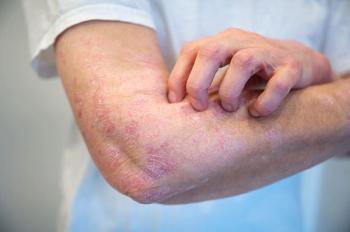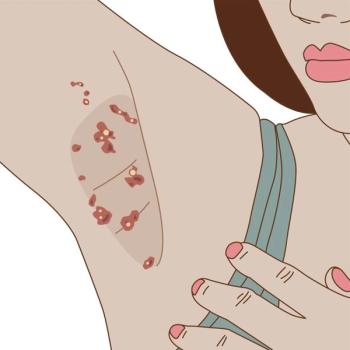
Viral Exanthem in a Young Boy
A 3-year-old boy is brought to the office by his mother. Theprevious evening, she had noticed a single large red spot on the back of histhigh. This morning, his whole body was covered with a similar rash, andhe had a temperature of 38.8°C (102°F). The mother administered 1 doseof acetaminophen at home for the fever; the rash was asymptomatic.
THE CASE:
A 3-year-old boy is brought to the office by his mother. Theprevious evening, she had noticed a single large red spot on the back of histhigh. This morning, his whole body was covered with a similar rash, andhe had a temperature of 38.8
o
C (102
o
F). The mother administered 1 doseof acetaminophen at home for the fever; the rash was asymptomatic.During the previous week, the child experienced vomiting, diarrhea,and abdominal pain of several hours' duration. There is no history of trauma,recent travel, tick bites, contact with sick persons, headache, cough,rhinorrhea, stiff neck, sore throat, or joint swelling. The child is not takingany medications or herbal remedies. He was born prematurely at 34 weeksand has a history of atopic dermatitis.On examination, the child is afebrile, alert, and active, and displaysage-appropriate behavior. The rash consists of generalized symmetric largetarget lesions with erythematous raised borders and nonscaly pale centerson the trunk, buttocks, extremities, and face. The examination is unremarkableexcept for the rash.Which of the following conditions in the differential do you suspect?
- Henoch-Schnlein purpura (HSP)
- Erythema multiforme minor
- Erythema migrans
- Viral exanthem
DISCUSSION:
The child was admitted to the hospitalfor further observation and evaluation. Results of a completeblood cell count with differential, a basic metabolicpanel, and urinalysis were normal. Mycoplasma titers,blood cultures, and a direct fluorescent antibody nasalswab for respiratory viruses all had negative results.A diagnosis of
viral exanthem
was made. The child continuedto be afebrile and the rash faded markedly thenext day.Viral exanthems caused by enteroviruses may occurthroughout the year; the incidence peaks during the latesummer and fall. The cutaneous eruption may appear asa morbilliform, vesicular, petechial, or urticarial rashwith target lesions; it is usually associated with fever. Infectionscaused by cytomegalovirus, Epstein-Barr virus,and respiratory viruses may be associated with macular,morbilliform, or urticarial exanthems, which sometimesare difficult to differentiate from drug rashes. Target lesionsthat are intensely pruritic suggest urticaria. Thediagnosis of a viral exanthem is made by exclusion, asit was in this case. Treatment is not given unless a bacterialcause is suspected, in which case empiric therapyis prescribed until the diagnosis is established.
HSP
was suspected initially because the child had arecent history of diarrhea and abdominal pain followedseveral days later by the rash on his lower extremities.HSP, a vasculitis of small vessels, is the most commoncause of nonthrombocytopenic purpura in children. Therash can initially resemble target lesions, but typically itbegins as pink maculopapules that progress to petechiaeor palpable purpura. The lesions evolve from red topurple to rusty brown before eventually fading. Severalorgan systems may be involved during the acute phaseof the disease, resulting in arthritis, renal and GI manifestations,edema in dependent areas, and occasionallyhepatosplenomegaly and lymphadenopathy. CNS involvementoccurs rarely but may result in serious complications.Because there are no diagnostic laboratory testsfor HSP, a thorough history and physical examinationare essential.
Erythema multiforme minor
is a distinctive acutehypersensitivity syndrome that may be caused by anumber of viruses, as well as by medications, bacterialinfections, foods, and immunizations. It may also arisein association with connective tissue disorders. Medicationsand infectious diseases are the most common triggersin children. A symmetric rash usually appears onthe dorsa of the hands and feet and extensor surfacesof the arms and legs. The palms and soles are commonlyaffected. The initial lesions are dusky red macules orpapules that evolve into target lesions with multiple concentricrings of color change. In most children, mucousmembrane involvement is minimal or absent. The diseaseis self-limited. Systemic manifestations are limitedto low-grade fever, malaise, and myalgia. Treatment consistsof symptomatic support and reassurance.
Erythema migrans
marks the onset of Lyme disease,the most common tick-borne illness in the UnitedStates. Lyme disease is caused by the spirochete
Borreliaburgdorferi,
which is transmitted to humans throughthe bite of an infected tick of the
Ixodes
species. Mostcases occur in southern New England, the eastern MiddleAtlantic states, and the upper Midwest. The onsetof illness, which corresponds to the life cycle of the tick,usually occurs between May and October. Most casespresent in June and July.A single papule erupts 3 to 30 days after a tick biteand expands quickly to form an enlarging annular redplaque with central clearing. The secondary lesions,which may develop several days later, are usually smallerthan the primary lesion and are commonly accompaniedby fever, myalgia, headache, malaise, conjunctivitis,and lymphadenopathy. Other manifestations may includeaseptic meningitis, uveitis, or carditis. Paralysis of thefacial (seventh) cranial nerve, which is more common inchildren, is usually idiopathic; however, it may be a presentingsign of Lyme disease.Arthritis, the hallmark of late disease, tends to involvelarge joints; the knee is affected in 90% of cases.CNS involvement in children is rare. The diagnosis canbe made clinically in the early stages of the diseasebased on the presence of erythema migrans. Serologictesting is the standard of diagnosis in later stages. However,serologic testing is not recommended for childrenwith nonspecific symptoms and those with no history ofexposure or for children in areas where Lyme disease isnot endemic. Antibiotic therapy is required at all stagesof Lyme disease.
References:
FOR MORE INFORMATION:
- Behrman RE, Kliegman R, Jenson HB, eds. Nelson Textbook of Pediatrics.Philadelphia: WB Saunders Co; 2000:728-729, 911-912, 1989-1990.
- Cohen BA. Atlas of Pediatric Dermatology. London and St Louis: Wolfe; 2000:105-106, 154, 156-160, 165-166, 171-172.
- Zitelli BJ, Davis HW. Atlas of Pediatric Physical Diagnosis. Philadelphia: Lippincott;1992:191-192, 203-204, 232-233.
Newsletter
Enhance your clinical practice with the Patient Care newsletter, offering the latest evidence-based guidelines, diagnostic insights, and treatment strategies for primary care physicians.





























































































































































































































































































































